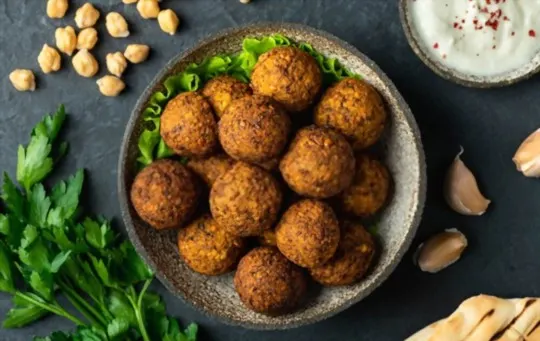Craving a delicious bite of falafel? Wondering if it will suit your tastes? You’ve come to the right place.
In this article, we provide everything you need to know about falafel: its ingredients, flavors and preparation.
Discover the tantalizing world of Falafel and make sure your next dish is a satisfying one.
What is Falafel?

Falafel is a traditional Middle-Eastern food, widely recognized as a classic street food.
It was originally made with fava beans, but over time has been adapted to include chickpeas which are now the most common.
It may take the form of a small patty or ball, and is made from a mixture of legumes, herbs and spices that have been combined and deep fried in oil.
The flavor is always aromatic and savory, featuring garlic, onion, cumin and coriander as essential ingredients.
In addition to its flavor components, falafel is also prized for its versatility; it can be served fresh in warm pita bread with chopped vegetables and sauces or dressed up with flavors such as tahini or Greek yogurt.
It can even be served cold as part of salads or as snacks.
Its crunchy exterior also adds texture to any dish.
What Does Falafel Taste Like?

Falafel is a Middle Eastern food made of spiced chickpeas and/or fava beans, usually served in pita bread.
The flavor of falafel can vary depending on the seasonings used but typically they have a savory, earthy, nutty flavor that can be described as having notes of parsley and cumin.
The texture of falafel is generally crunchy on the outside with a soft center.
It can either be formed into balls or patties and served hot or cold.
Falafel can be dressed with traditional Middle Eastern sauces such as tahini or hummus for more flavor.
One popular way to enjoy falafel is in a wrap or sandwich with some fresh fruits, veggies and condiments like tomato, lettuce, pickles, tzatziki sauce or tahini dressing.
This combination gives falafel a delicious balance between the crunchy exterior and the creamy sauces making it one flavorful dish.
Ingredients that Affect the Taste of Falafel

The taste and texture of classic falafel are the result of a combination of many different ingredients.
Traditional Middle Eastern recipes use ground or mashed chickpeas as their base.
Other ingredients like onions, garlic, flavorings, spices, and herbs may be added for enhanced taste.
The addition of a grain-like bulgur wheat can give falafel an extra crunchy texture.
After the chickpeas and other ingredients are combined, the balls can be freshly fried in oil to order.
It is also possible to bake or roast pre-made falafel balls for a healthier option that still maintains that classic flavor and texture.
Different regions will often have their own take on the dish by altering some of the common ingredients or adding additional seasonal ingredients like sugar, peppers, turmeric, lemon juice, orange blossom water or even molasses.
Falafel has been around since ancient times so it’s no surprise that there are so many variations on this popular dish throughout its history.
The main element contributing to the flavor profile of any type of falafel is with how much salt it contains as well as what spices are used in creating it.
You’ll find subtle variations in taste between countries—for example North African styles tend to favor sweeter items such as dates while Levantine varieties often include pickles or sumac for an added tangy kick.
These regional nuances make falafel one of those unique dishes with something new to experience somewhere on your culinary journey each time you try it.
1 – Chickpeas
Chickpeas, also known scientifically as Cicer arietinum, are the key ingredient of falafel.
These round, nutty flavored legumes are incredibly versatile and can be used in salads and stews or turned into hummus or puréed into thick spreads or even baked into chips.
When it comes to falafel, chickpeas are usually soaked overnight and then dried and ground, creating a paste which is then mixed with spices, onions and herbs such as parsley and cilantro, resulting in the delicious deep-fried treat we all know.
Chickpeas offer up a unique blend of flavors – creamy yet earthy with hints of nuttiness – that come together to form the perfect vehicle for flavorful sauce and crisp vegetables.
2 – Herbs and Spices
Falafel is a traditional Middle Eastern food made of ground chickpeas, herbs, and spices that is deep fried and served in a pita pocket.
In addition to chickpeas, falafel usually has a combination of vegetables such as onion and garlic, herbs such as parsley, cilantro, and mint, and spices such as coriander, cumin, cardamom, cinnamon and paprika.
The deep-fried balls can be served either warm or cold with various condiments like hummus or tahini sauce that add flavor to the dish.
The principal special aroma of falafel comes from the herbs used in its preparation.
Parsley gives the main flavor with its vibrant green color and spicy herbal taste; cilantro adds an intense citrus-like flavor; mint adds a hint of sweetness; coriander adds lemony notes with earthy undertones; cumin provides earthiness; cardamom adds an exotic warm scent; cinnamon provides faint sweetness with a spicy note; paprika imparts smoky tones.
All these flavors together create the unique flavor profile of falafel.
In addition to the herbs and spices above, many cooks also add ingredients like garlic powder for bite or onion powder for richness.
Different regions in Middle Eastern countries prepare this traditional dish differently by adding different combinations of ingredients to it depending on their local tastes.
Adding other flavors like chili powder can also make falafel spicier or tangy tamarind paste can give it more depth – creating an even wider variety in falafels flavors around the world.
3 – Other Ingredients
The other ingredients used in the traditional falafel recipe are just as important as the chickpeas.
The ingredients can vary from region to region, but usually include garlic, parsley, sea salt, pepper, cumin and coriander.
Some types of falafel also have a small amount of baking powder or baking soda added to help bind the patty together.
Depending on where you get your falafel from, it may also have onion or herbs such as dill and mint added for additional flavor.
The combination of chickpeas, spices and herbs gives falafel its signature flavor.
Its savory taste can be likened to that of hummus with a slight nutty flavor coming through due to the chickpea base.
The texture is light and crispy on the outside yet soft and creamy on the inside — perfectly balanced in both texture and taste.
How to Make Falafel to Enhance its Flavor

Falafel is a delicious and popular Middle Eastern dish found all over the globe.
It’s typically made from ground chickpeas and a mix of spices, deep-fried into little patties or balls.
To make falafel, start by soaking dried chickpeas overnight to soften them up.
Next, puree the chickpeas in a food processor with spices such as garlic, cumin, cilantro, parsley, coriander, and lemony sumac.
Once blended together the mixture is rolled into balls or patties and deep-fried until golden brown and crispy.
Adding baking soda to your mixture will help keep your falafel light and fluffy inside while providing a slightly crispy outside texture when fried.
The flavor of falafel can vary depending on what type of spices you use but it’s generally savory with a hint of sweetness from the chickpeas.
Serving your falafel in fresh pita bread or wraps along with fresh vegetables such as tomatoes, lettuce, pickled cabbage or cucumbers can be an excellent way to enjoy this tasty dish.
And if you’re looking for something extra special to add that unique flavor boost – plate up your falafels with some traditional tahini sauce.
Serving Suggestions and Pairings for Falafel
Falafel is a Middle Eastern dish made of ground chickpeas, fresh herbs and spices, formed into balls or patties and deep fried.
It’s crunchy on the outside but soft and fluffy on the inside.
Falafel has a nutty flavor, with notes of cumin, garlic and lemony tang.
The color of falafel can range from golden brown to dark purple depending on the ingredients used.
The best way to enjoy falafel is served hot, either as is or in a sandwich like shawarma/gyros or in a wrap/pita with vegetables and tahini sauce.
They also make great toppings for salads or as a side dish when served with hummus, tzatziki sauce or baba ganoush.
You can also serve falafel with sliced tomatoes, pickles and feta-cheese salad or top off your favorite soup for extra crunch.
When it comes to pairings, you can’t go wrong with anything Mediterranean like wine-marinated olives, pitas breads or cheese platter.
Other good accompaniments include couscous salad, bulgur wheat tabouleh salad and even regional dishes such as Turkish sarma (stuffed vine leaves).
And if you’re looking for something sweet after such flavorful meal try some baklava – decadent Middle Eastern pastry filled with nuts and rolled up in paper thin sheets of filo dough – guaranteed crowdpleaser.
Nutritional Value and Health Benefits of Falafel

Falafel is a popular Middle Eastern street food that has gained popularity across the globe for its flavorful taste and nutritional benefits.
Made with ground chickpeas, garlic, and spices, it is often served as a sandwich or with salads and dips.
While falafel can be high in fat, it is also an excellent source of vitamins, minerals, and protein.
Here are some of the health benefits that come from incorporating falafel into your diet.
Nutritionally speaking, falafel is rich in many vitamins and minerals.
It contains substantial amounts of iron, magnesium, phosphorus, zinc and copper—all important for overall health.
Falafel is also an excellent source of dietary fiber which helps to reduce blood sugar levels as well as promote digestion and regularity.
For those looking to include more plant-based protein sources into their diets, falafel provides a generous helping at 8-10 grams per serving of three balls (about ¼ cup).
Additional nutritional components include vitamin C, potassium, B Vitamins, folate (vitamin B9), essential amino acids, fatty acids omega-3 and omega-6.
Eating falafel can have many beneficial effects on your health due to its nutrient composition.
The presence of fiber helps to regulate digestion by promoting regularity.
It also helps to slow the release of sugar into the bloodstream which can help reduce cholesterol levels and improve heart health overall due to its anti-inflammatory properties found in certain fatty acids such as omega-3s.
Additionally these fatty acids play an important role in brain function helping improve memory, focus, clarity -all related to mental wellbeing.
Finally including falafel regularly into your meals adds essential B vitamins which help support energy levels throughout the day as well as nervous system maintenance.
Where to Buy Falafel and How to Store It

When it comes to buying Falafel, there are several different options.
You can find packaged, fried falafel in many stores, including health food and Middle Eastern markets.
These ready-made balls will often run from three to five dollars per package.
Alternatively, you can buy dry mix such as “Man’ousheh Mix” for about two dollars per package.
This mix is made from ground dried garbanzo beans that you would just add your own water and oil to before frying or baking.
If you want freshly made Falafel you can check with local restaurants or specialty shops for a variety of flavors and styles.
Once you’ve acquired some Falafel, make sure that it’s stored in an airtight container in the refrigerator so that it won’t spoil quickly.
To heat up leftovers, place the falafel balls on a baking tray and bake at 350°F (176°C) for ten minutes or until they are heated thoroughly throughout.
For best results, reheat individual servings as needed to prevent sogginess or burning the outside of the falafel balls while leaving the inside cold.
Conclusion
Ultimately, the taste of falafel is delightfully complex and highly dependent on the ingredients used, the way it is cooked, and which accompaniments it is served with.
Whether you prefer a crunchy texture or a softer dough-like consistency, there are endless variations to be enjoyed as part of a Mediterranean feast.
The essence of falafel lies in its distinctive flavor created by combining spices such as cumin, paprika and coriander with either mashed chickpeas or fava beans.
The addition of herbs like garlic and parsley, along with freshly squeezed lemon juice, provides a delicious citrus note to elevate this vegetarian delight from humble to heavenly.
Finally, food lovers who enjoy adding some spice to their life can find many recipes that incorporate chilis for an extra kick.

What Does Falafel Taste Like? A Comprehensive Guide
Ingredients
- Falafel
- Ingredients from your selected recipes
Instructions
- Select your favorite ingredient from the range available in this article.
- Collect all the necessary items to make the recipe.
- Use the instructions provided to prepare a delicious dish in 30 minutes or less.

Carrie is a food writer and editor with more than 15 years of experience. She has worked for some of the biggest names in the food industry, including Bon Appétit, Food & Wine, and Martha Stewart Living.
As the Editor in Chief of IntroChicago.com, Carrie oversees all of the content on the site. She also manages the team of contributing writers and editors, who help to create delicious recipes, helpful tips, and informative articles that you’ll find on the site.
A native of the Chicago area, Carrie is passionate about all things food. She loves trying new restaurants and experimenting with new recipes in her kitchen. She’s also a graduate of the Culinary Institute of America, so she knows a thing or two about food!
